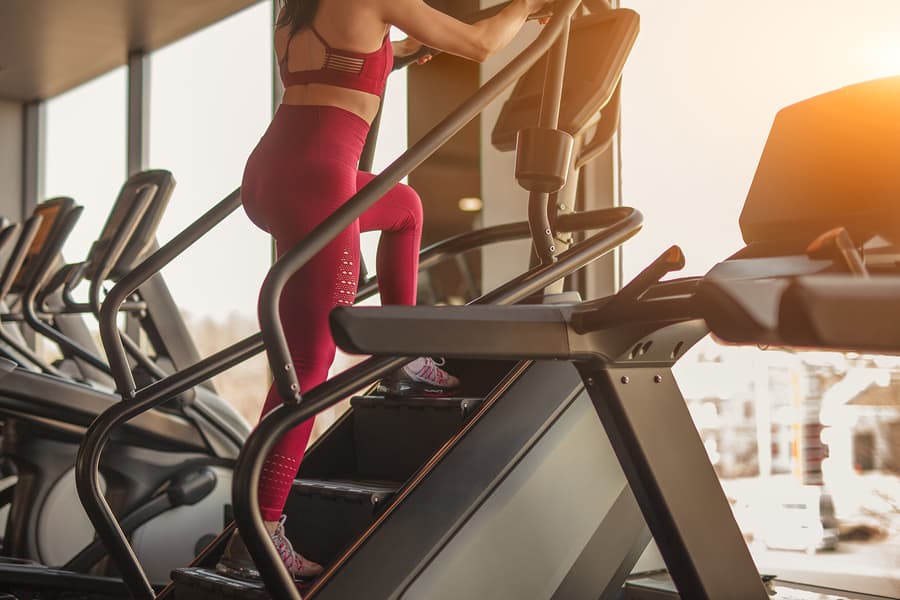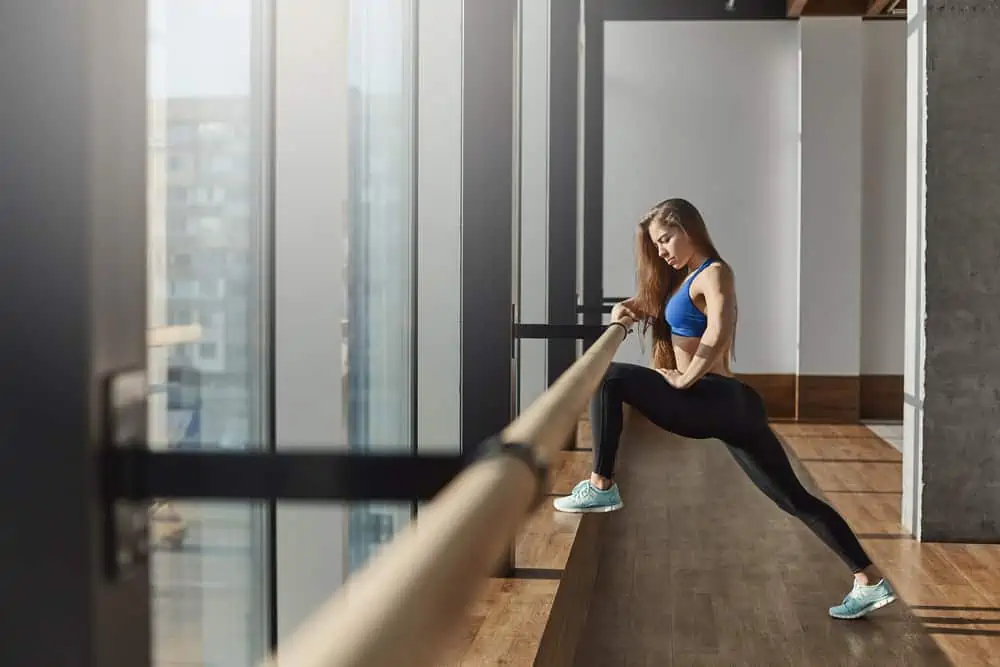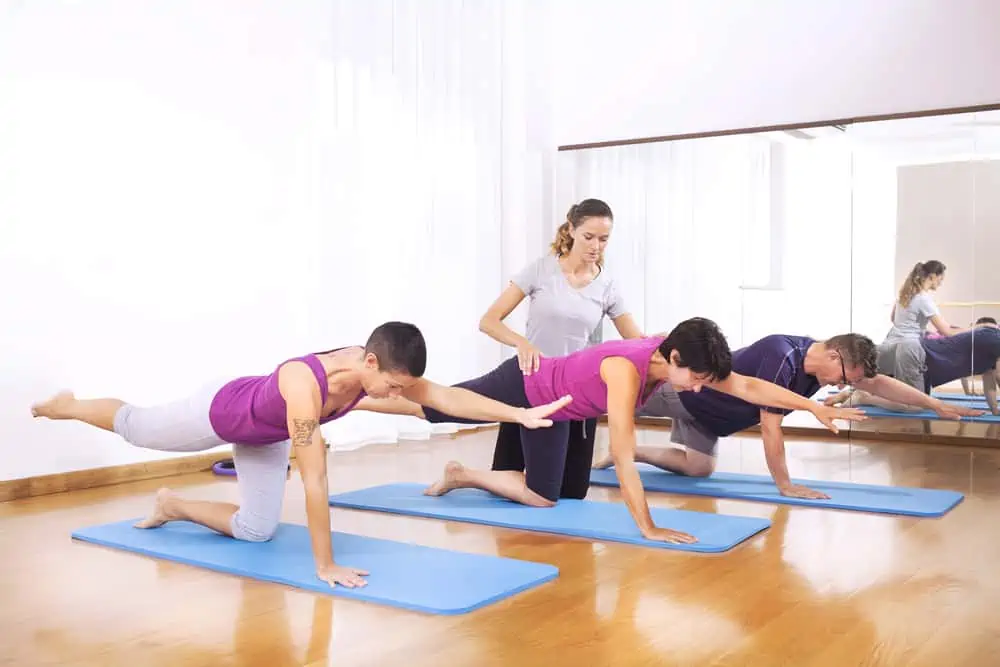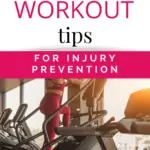This post may contain affiliate links. If you click through a link and make a purchase, I may receive a commission at no additional cost to you. As an Amazon Associate, I earn from qualifying purchases. Read the full disclosure here.
Stair climber machines are making a comeback. There can be some stiff competition for this fitness equipment at peak times, and for good reason.
Before you go running up the stairs, there are a few things that can sabotage your workout and put you at risk for injury.
This article will highlight some critical stair climber workout mistakes you need to stop making!
Related read: What Muscles Does The Stairmaster Work?
Disclaimer: This content is for educational purposes and is not medical advice. Read the full disclaimer.
Are you making these Stairmaster workout mistakes?
1. Staying on your toes the entire time
If I had a dollar for every person I’ve seen climbing up on their tippy-toes.
Why does it matter?
It’s about optimizing your movement for the best muscle activation.
Injury, weakness, and poor form can alter these patterns leading to overuse and injury of other muscles that were just there to pick up the slack.
The body likes to move in patterns, meaning several muscles work together to perform movements.
By staying on your toes, you’re keeping your calf muscles active the entire time, altering the mechanics of how you move.
My guess is that you got on the stairs to work your quadriceps and glutes.
If you do a lot of stair climbing on your toes, you might find yourself with some pretty tight calf muscles. This type of movement pattern can also contribute to plantar fasciitis or Achilles tendonitis.
Related reads:
- Surprising Reasons Why Your Plantar Fasciitis Isn’t Getting Better
- Plantar Fasciitis vs. Achilles Tendonitis – What’s the Difference
- Why Does My Achilles Always Feel Tight (14 Possible Causes)
Here’s what to do instead
Place more of your foot on the step and drive through the heel. Pushing through the midfoot and heel will help engage the glute muscles more effectively.
The glutes were designed to perform heavy work, for example, when climbing stairs, propelling forward with walking, or even getting up from a chair.
My guess is, targeting your glutes was a big reason for getting on the stair climber in the first place.
2. Stairmaster kickbacks
I’m not sure when the kickbacks on Stairmaster became a thing, but I’m going to take a stance and say I’m not a fan – and quite frankly, it’s a little disturbing that more people aren’t catching on to this.
But the fitness industry is great at spreading total nonsense. Just because it’s the newest craze, that doesn’t mean you should be doing it.
Before you form a line around the block, let me explain.
Cardio machines can be monotonous. I get it. It might feel like you’re adding some flair to an otherwise dull and repetitive workout.
Many articles even encourage adding kickbacks on Stairmaster and claim that you’re “toning your glutes”.
Here’s the “kicker”: You’re not getting booty gains from kicking back on a stair climber machine AND it can aggravate your lower back (AND it’s just plain silly).
Here’s why.
When I see people performing said kickback, I typically see increased extension at the lumbar spine from forcefully whipping their leg backward as they feverishly strain to keep up with the pace of the machine.
Aggressively extending the lumbar spine can exacerbate existing conditions or cause new issues.
Not to mention, if you’re flailing your legs around, you’re using momentum and not putting intention into the movement, which is the whole point when you’re trying to strengthen.
There are a lot of ways to cheat movements and render them useless.
Not all exercises and movements are created equal and the ever-popular Stairmaster kickback is not giving you the results you’re after anyway.
If you’re thinking, “But what if I can do the kickback correctly?”
Great question.
If you can properly control the movement, that’s fine, but what’s your goal for doing it in the first place?
If you’re trying to strengthen your glutes, there are better ways to do it (that actually work). For strength gains that you can see and feel, you need to apply load and be working against resistance.
Some alternate options are squats, lunges, bridging, leg extensions with a cable machine, donkey kicks, and leg press just to name a few.
With these exercises you’ll be able to focus on proper form and strength training, rather than quickly bringing your leg back, so you don’t miss a step.
Don’t just do things because you see other people doing things.
Get to know why you’re doing what you’re doing.
For an easy review of lower body muscles and exercises that match, check out my article The Complete Guide To Lower Body Muscles For Exercise.
You can find other articles for upper body and core in my Fitness Anatomy section.

3. Use caution with climbing sideways
This is another popular move nowadays, so let me explain why this is a risky move for some people. If you’re experiencing hip or knee discomfort, you’ll want to skip this, at least until you’re feeling better.
The hip abductors (the muscles on the side of your hip) are often a neglected area of focus in exercise, and they serve such an important function for stabilizing the pelvis (which affects mechanics at the knee).
Weakness at the hip changes our movement patterns and places additional stress further down the leg, such as the knee and ankle.
Hip abductor weakness can also affect the low back.
If you notice that your knees collapse inward or have discomfort while doing this motion, there’s an issue.
Your body will always figure out how to accomplish a motion, often with bad mechanics at the expense of overusing the wrong structures.
If you’re looking to perform side step-ups and control your knee alignment, use an aerobic step platform in the gym and keep yourself safe.
Use a BOSU ball round-side up if you’re looking to add a balance challenge.
Isolating form on exercises can be challenging enough without adding a moving surface into the equation. Sometimes the basics are the best to accomplish the goal.
When the goal is to work your hip abductors, you can get more bang for your buck elsewhere, sans risk of falling down a moving staircase.
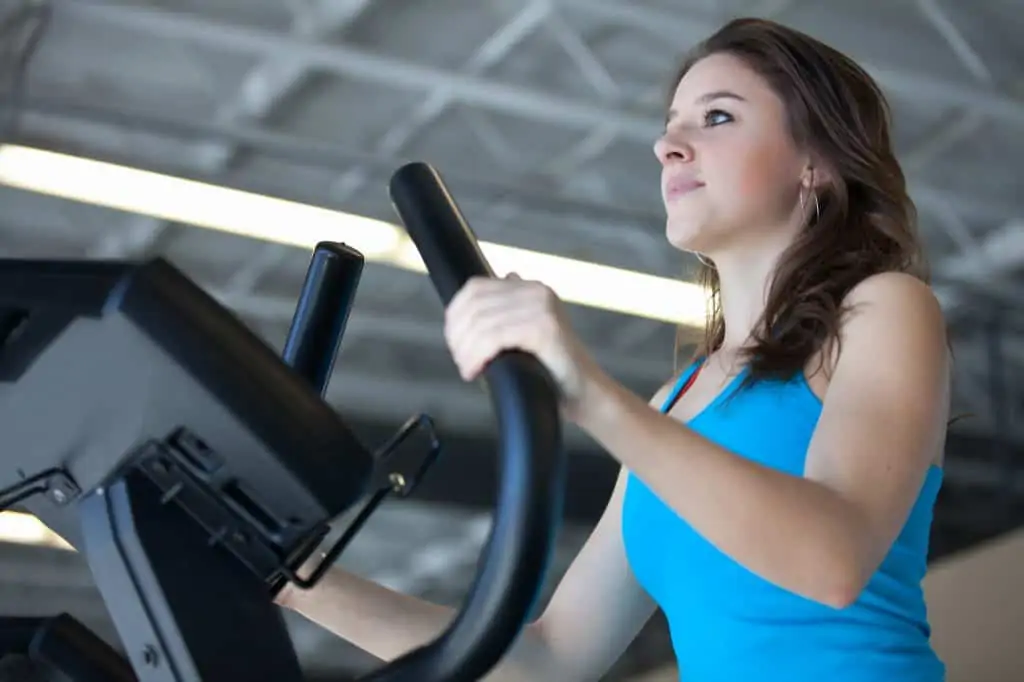
4. Stand up straight!
Internal eye roll and sigh whenever I see someone slumped over the handrails of a stair stepper with their neck cranked up to stare at their phone.
Many people do this to crank up the level, go faster, but make it feel easier. If you need to lay over the machine, you’re doing it wrong.
Stand upright with hands placed (lightly) on the handrails and let your legs do the work.
Avoid leaning or slumping over the machine to support yourself. This may mean you need to adjust the level.
Slumping over the machine gives you a false sense of efficiency. Good posture will give you a better workout with less risk of injury.
Slouching forward overworks neck and back muscles. These are the same muscles that are already overworked with poor posture slumped over a computer or phone most of the day.
You took time out of your busy day to get a workout in, might as well do things the right way.
Stair climber vs. stair stepper
Let’s first talk about the difference between these two types of fitness machines.
A stair climber looks like a staircase that rolls around the machine for you to keep climbing.
A stair stepper has pedals that you pump up and down but you’re really just sort of marching in place unless you take the machine up to a high setting.
Sometimes people refer to both of these machines as a Stairmaster, but Stairmaster is really just a brand that makes these types of fitness machines. It’s like saying “Kleenex” instead of tissue.
Which machine is better? They both have cardio benefits, however a stair climber has the potential to work your muscles better in a more functional way.
Most tips here apply to both types of cardio machines.
PS – You can make cardio machines less boring with guided audio workouts. Get a free 30 day trial of Aaptiv fitness here with workout classes for stair climbing machines, ellipticals, treadmills, and more.
How to make stair climber workouts less boring
Just climbing stairs is super boring which is probably why you see people kicking, spinning, and doing all kinds of silly things to avoid the repetitive mental drag.
One way to make your workout more exciting is to use a fitness app like Aaptiv that has fitness classes for cardio equipment.
I use this app all the time for stair climbers, ellipticals, and treadmills to pass the time and made the workout less monotonous. They have classes of all lengths and levels and the trainers take you through different intervals or HIIT workouts.
Before you know it, your time is done!
You can read my full review of Aaptiv here where I go deep into all the features of this versatile fitness app.
Grab a 30-day FREE trial of Aaptiv workouts here.
Another fun way to add motivation and variety to your workouts is searching the pre-mixed cardio fitness albums on Amazon Prime Music.
These albums are mixed to heart-pumping BPMs to match the pace of your workout and help you get into the groove.
Wrapping up
Stair workouts are a great, low-impact way to improve cardiovascular fitness and build strength in the lower body.
Stair machines offer another cardio option from the same old treadmill and elliptical machine.
Your time is valuable, don’t waste it on poor form.
Don’t just do things simply because you see other people in the gym doing it. Get to know why you’re doing what you’re doing.
Keep these stairmaster workout tips in mind for your next stair climber workout to keep yourself active and safe!
Featured image credit: kegfire / bigstockphoto.com

